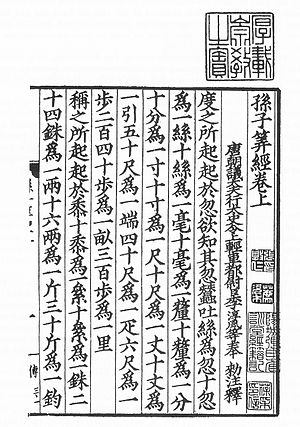
Sunzi Suanjing (Chinese: 孫子算經; pinyin: Sūnzǐ Suànjīng; Wade–Giles: Sun Tzu Suan Ching; lit. 'The Mathematical Classic of Master Sun/Master Sun's Mathematical Manual') was a mathematical treatise written during 3rd to 5th centuries CE which was listed as one of the Ten Computational Canons during the Tang dynasty. The specific identity of its author Sunzi (lit. "Master Sun") is still unknown but he lived much later than his namesake Sun Tzu, author of The Art of War. From the textual evidence in the book, some scholars concluded that the work was completed during the Southern and Northern Dynasties.[2] Besides describing arithmetic methods and investigating Diophantine equations, the treatise touches upon astronomy and attempts to develop a calendar.[citation needed]
- ^ Lam Lay Yong and An Tian Se. "Fleeting Footsteps", p. 4. World Scientific. ISBN 981-02-3696-4.
- ^ For instance, in problem 33 of volume 3, it is written, "Luoyang is 900 li away from Chang'an". As the name "Chang'an" was first employed during the Han dynasty, this work could not have been written before the 3rd century. Additionally, in problem 3 of volume 3, Sun Tzu writes "We have a board game, 19 rows and 19 columns square. Question: how many stones are there?" Since go made its first appearance in the mid-3rd century, the work was most probably written during the Wei or Jin dynasties.[1]
